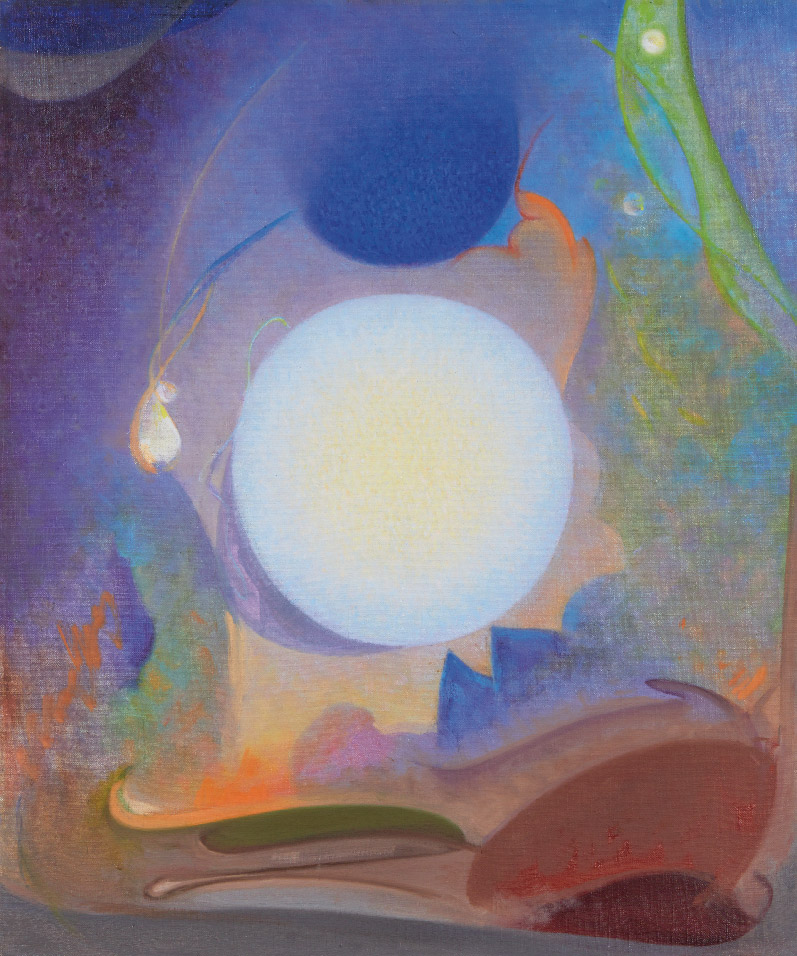Later Work and Legacy
By the 1950s, Pelton’s health was failing, and on March 13, 1961, she passed away from liver cancer. Leaving no immediate heirs, her belongings were distributed to her cousins. In a letter written on July 28, 1961 to Pelton‘s cousin Laura Gardin Fraser, Pelton’s friend and caretaker Gerry Goodall recounts: “I get sick every time I think of the abstraction Agnes gave to the Santa Barbara Gallery—worth many hundred dollars, and because the curator didn’t understand or like abstractions, put it in the White Elephant Sale for $40.00. Alice Kennedy saw it, and while she was out cashing a check to buy it—the price had been reduced to $15.00.”
Pelton’s slow reemergence within the margins of American art began through critical and academic reevaluations of her place in art history. In the 1980s, archival efforts aimed at establishing a baseline of primary research materials began to take shape. The Agnes Pelton papers at the Smithsonian Institution were assembled by Cornelia and Irving Sussman for a biography of Agnes Pelton. They were donated to the Archives of American Art by gallery director Jan Rindfleisch on behalf of the Sussmans in 1984. The majority of her works were cataloged in a publication for an exhibition curated by the art historian Margaret Stainer in 1989, which was followed by the exhibition curated by Michael Zakian at Palm Springs Desert Museum in 1995.
En la década de 1950, la salud de Pelton empeoraba y el 13 de marzo de 1961 falleció de cáncer de hígado. Sin dejar herederos inmediatos, sus pertenencias fueron distribuidas entre sus primos. En una carta escrita el 28 de julio de 1961 a la prima de Pelton, Laura Gardin Fraser, la amiga y cuidadora de Pelton, Gerry Goodall, cuenta: “Me enfermo cada vez que pienso en la abstracción que Agnes le dio a la Galería de Santa Bárbara, que vale cientos de dólares, y debido a que el curador no entendía o no le gustaban las abstracciones, la puso a la venta con los cachivaches por $40.00. Alice Kennedy la vio y mientras estaba cambiando un cheque para comprarla, el precio se había reducido a $15.00”.
El lento resurgimiento de Pelton dentro de los márgenes del arte estadounidense comenzó a través de reevaluaciones críticas y académicas de su lugar en la historia del arte. En la década de 1980, comenzaron a tomar forma los esfuerzos de archivo dirigidos a establecer un punto de partida sobre materiales de investigación primaria. Los documentos de Agnes Pelton en la Institución Smithsonian fueron reunidos por Cornelia e Irving Sussman para una biografía de Agnes Pelton. Fueron donados en 1984 a los Archivos de Arte Americano por el director de la galería Jan Rindfleisch en nombre de los Sussman. La mayoría de sus obras fueron catalogadas en una publicación para una exposición curada por la historiadora de arte Margaret Stainer en 1989, seguida por la exposición curada por Michael Zakianen en el Museo del Desierto de Palm Springs en 1995.

Interval, 1950, Oil on canvas, Collection of Lynda and Stewart Resnick
Interval is one of many of Pelton’s paintings that center on a circle, a form with no beginning and no end that has often been used by artists to suggest infinity and self-contained harmony. Not surprisingly given Pelton’s belief in the power of certain shapes to convey “the higher possibilities of vision,” she incorporated circles in her compositions to suggest the calm radiance at the center of a storm.
